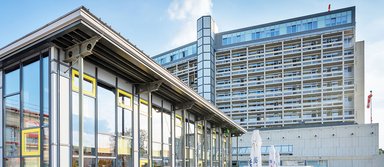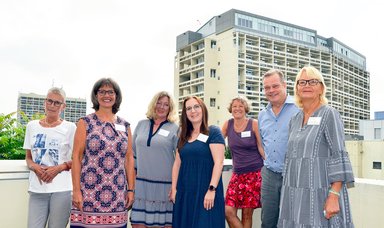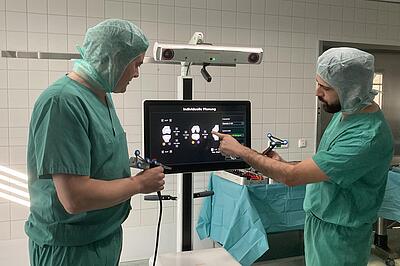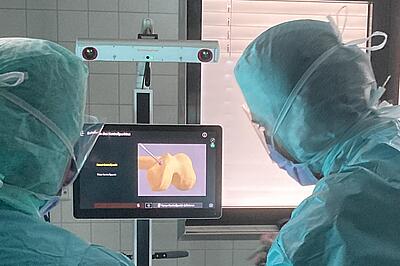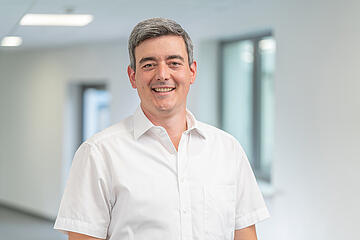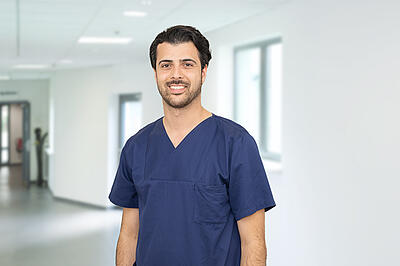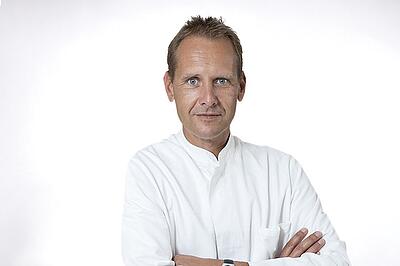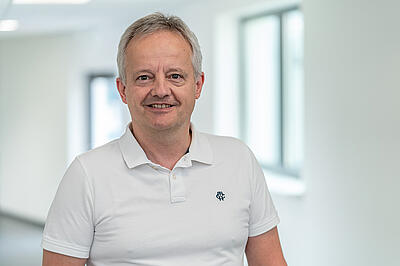Certified Maximum-Care Center for Joint Replacements at Krankenhaus Düren
Over the course of life, our joints naturally wear down. As medical professionals, we refer to this as osteoarthritis. It can affect any joint. Whether we like it or not, joint wear is a normal part of aging. However, some people experience osteoarthritis more severely than others. In 2024, our growing and highly specialized team, together with the latest technology in robotic-assisted knee joint replacements, enabled us to implant and perform nearly 650 joint replacements.
For all major joint surgeries, we rely on muscle-sparing surgical techniques, aiming to achieve the fastest possible mobilization and recovery following hip or knee joint replacement surgery.
Head of section for joint replacement surgery
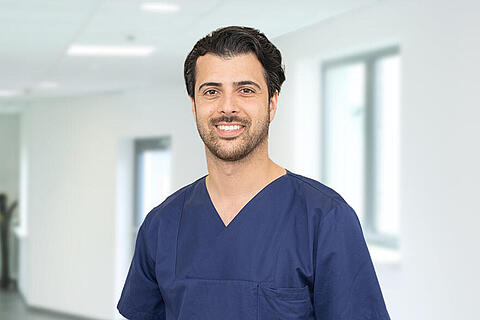
Ali Ghossein
Senior Consultant, Specialist in Orthopedics, Trauma Surgery and Emergency Medicine, ATLS Provider, Specialist in Robotic-Assisted Endoprosthetics
Spoken languages: German, English, Arabic, Dutch
Chief Physician
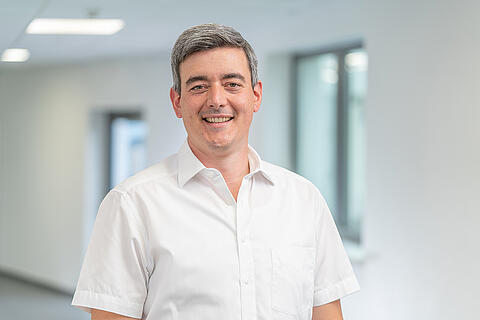
Priv.-Doz. Dr. med. Thomas Dienstknecht
Specialist in Orthopedics and Trauma Surgery, Advanced Trauma Surgery, Specialized Orthopedic Surgery, Sports Medicine, Emergency Medicine, Physical Therapy and Balneology, ATLS Instructor, Certified Foot Surgeon (DAF Certificate), Certified Spine Surgeon (German Spine Society)
-
How can Osteoarthritis manifest?
Walks become shorter. You wake up at night due to joint pain. You gradually become less mobile. Climbing stairs become difficult. Painkillers only provide temporary relief. Fortunately, there are many ways to help. In addition to targeted physical therapy, braces, walking aids, and a pain management plan tailored to your individual needs, one thing is particularly important: movement. After all, if you rest, you rust.
-
What do we do, if nothing else helps?
When mobility is so severely limited that quality of life suffers, and movement is no longer possible, a joint replacement surgery may be appropriate. Such a procedure can be performed on all major joints, though it is most commonly done on the hip or knee. With this surgery, we give patients renewed mobility and provide significant relief from pain.

An artificial joint (endoprosthesis) is often the most sustainable solution in cases of advanced joint disease, such as osteoarthritis, or after severe accidents, in order to restore the patient’s accustomed quality of life. For both hip replacement and knee replacement surgery – as a certified Endoprosthetics Center (EPZmax) of maximum care, we are specialists in artificial joint replacement, including complex revision and replacement surgeries.
We ensure your safety!
An artificial joint is an excellent solution, but certainly not a minor surgery. That is why we do everything possible to guarantee your safety. In addition to carefully assessing the indication (Do you really need an joint replacement at this point in time?), we offer state-of-the-art surgical techniques. Our operating theaters are specially equipped for major joint surgeries. The surgeons are highly trained specialists in their field, and only such experts are permitted to perform these operations with us. The anesthesia department provides, in addition to gentle anesthesia methods for older patients, regional anesthesia techniques in consultation with you.
-
Pain Management
Do not be afraid of pain after the surgery. We apply high-quality standards and train all involved staff to provide you with the best possible care. Our hospital hygiene team pays meticulous attention to cleanliness and sterility. In this area, we have already been awarded multiple prestigious quality seals.
-
Physiotherapy
Physiotherapy ensures rapid mobilization. Specially trained staff will support you in applying for your subsequent rehabilitation program. And of course, we are always there for you after the surgery as part of our consultation hours – whether you have questions right after your rehab stay or only years later. We walk this path together with you.
Robotic-Assisted Knee Replacements
Since January 2025, the Krankenhaus Düren has expanded its orthopedic services and now offers the next-generation robotic system. This technological advancement enhances knee joint replacement procedures by combining the surgeon’s expertise with state-of-the-art, hand-guided robotic technology.
FAQ – Most frequently asked questions about the CORI Surgical System
-
How does surgery with the CORI-Robot work?
The surgical robot is used in joint surgery for the implantation of an artificial knee joint. It allows for a highly precise, patient-specific placement of the prosthesis. Unlike other systems currently on the market, CORI does not use a saw – but a computer-controlled milling tool to remove bone material. A digital 3D representation of the bone structures also enables the surgeon to review and adjust each step of the procedure at any time.
-
What are the benefits of this new Technology?
The surgeon-guided robotic tool performs precise bone preparation and improves the positioning of the implants, as well as their alignment in both axis and rotation. The CORI system not only considers the bony axes but also incorporates the assessment of the ligament structures required for a successful operation into the planning algorithm. This allows the surgeon to better evaluate whether corrective measures would exceed the anatomical limits of the knee joint, thus preventing overloading of the patient’s ligaments. By linking both processes, the prosthesis is optimally implanted according to the natural movement of the knee joint. Additionally, the CORI technique is radiation-free, and unlike older methods, a preoperative CT scan is not required.
-
How about safety during surgery?
Absolutely yes! The instrument works similarly to a CNC milling machine and immediately shuts off if it moves outside the preplanned surgical area. This technology prevents deviations from the planned surgical steps and minimizes the risk of injuring soft tissues.
The surgeon can always rely on the proven implant technology. This means that the implants used in both conventional freehand and robot-assisted techniques are identical. In the highly unlikely event of a robot system failure, the operation can be switched back to the original surgical technique at any time.
-
Are there any disadvantages?
For hospitals using this advanced technology, high investment and maintenance costs arise, which are currently not covered by either private or statutory health insurance. Our clinic, however, covers these costs for all patients, regardless of insurance. As a result, widespread availability of robot-assisted technology in Germany is not expected in the foreseeable future.
-
Are there any study results?
High-quality long-term studies with large patient numbers that can prove better clinical outcomes for patients are not yet sufficiently available for the entire field of robot-assisted knee surgery. As with many other medical innovations, it will take several more years. However, scientific research, particularly from the USA and Australia, is already showing promising results.
-
What are the requirements?
A successful operation requires highly trained personnel. A specialized team of surgeons, surgical assistants, and operating room technicians at our clinic has been working with robot-assisted technology for a long time. These staff members have participated in numerous training programs both nationally and internationally, enabling them to seamlessly integrate the new technology into the surgical workflow.
-
Who benefits from robot-assisted Endoprosthetics?
We view robot-assisted surgery as an important complement to the already successful surgical techniques at our clinic, which have been in place for many years. This is reflected in our steadily increasing patient numbers as well as in the quality indicators of health insurance providers and the German Endoprosthesis Registry.
We currently see the benefits of robotic technology particularly in patients with significant axis deviations, such as bow legs (O-shaped) or knock knees (X-shaped), as well as in those with ligament instability and bone changes resulting from injuries. These patients are identified during the preoperative examination, which takes place several weeks before the planned procedure. This allows us to optimally prepare both the patient and our team for the surgery.
Contact and Appointments
Klinik für Orthopädie und Unfallchirurgie
Krankenhaus Düren
Roonstraße 30
52351 Düren
Chefarztsekretariat
Frau Alexandra Reiche
T 02421 30-1331
F 02421 30-191307
CH1-dur@artemed.de
Certification in Joint Replacements

Decades of surgical experience and the use of established and modern therapeutic methods are the two main pillars for certification as a Maximum Care Endoprosthetics Center (EPZ) by the German Society for Orthopedics and Orthopedic Surgery. Certified centers are required to provide consistently high-quality care in the endoprosthetic treatment of hip and knee joints.
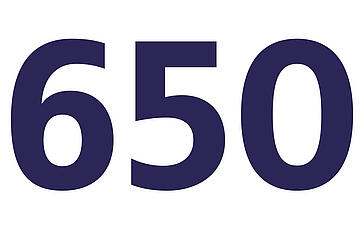
In 2024, approximately 650 endoprosthetic procedures were performed in the Clinic for Orthopedics and Trauma Surgery at Krankenhaus Düren.

